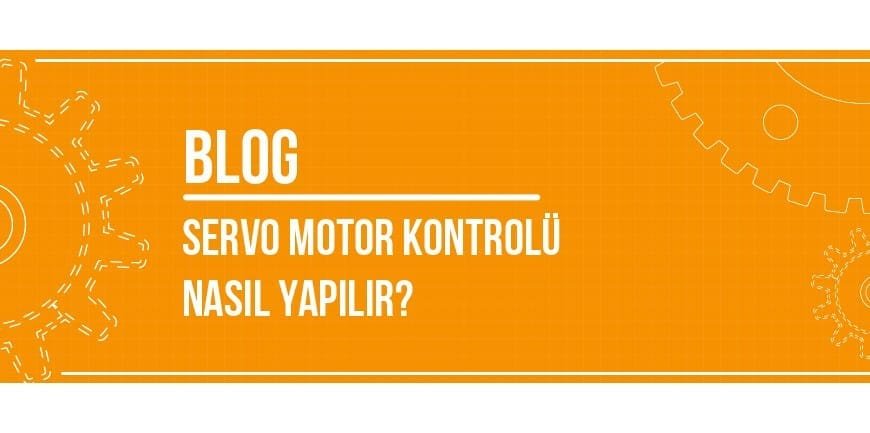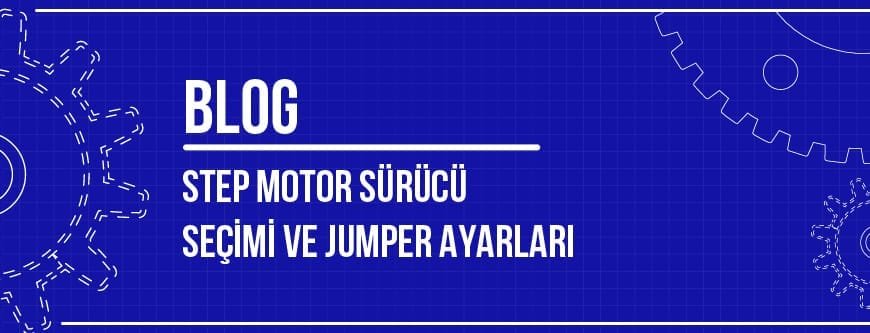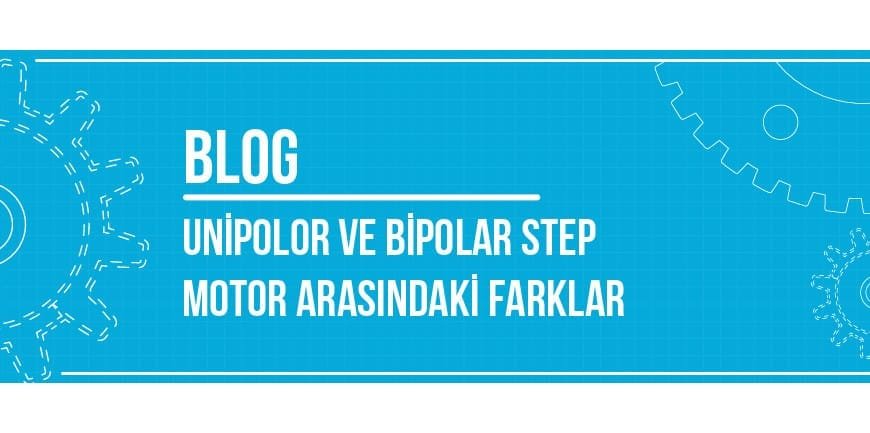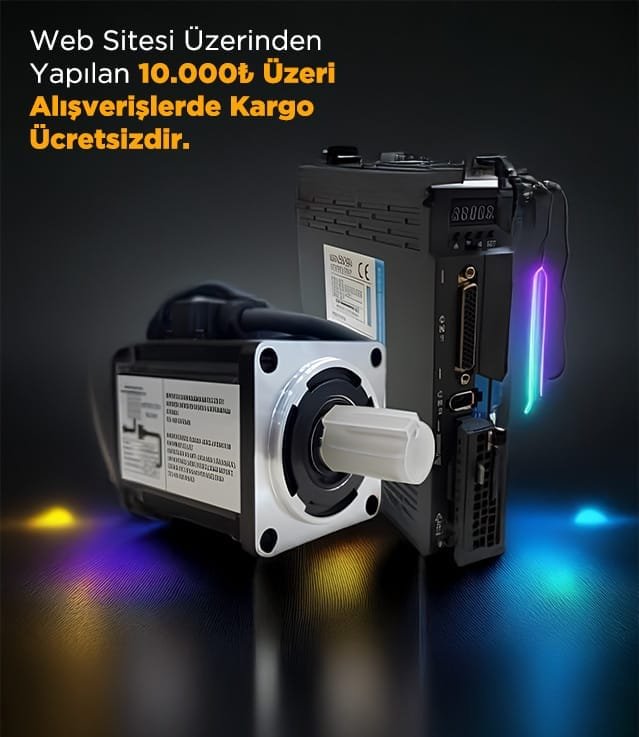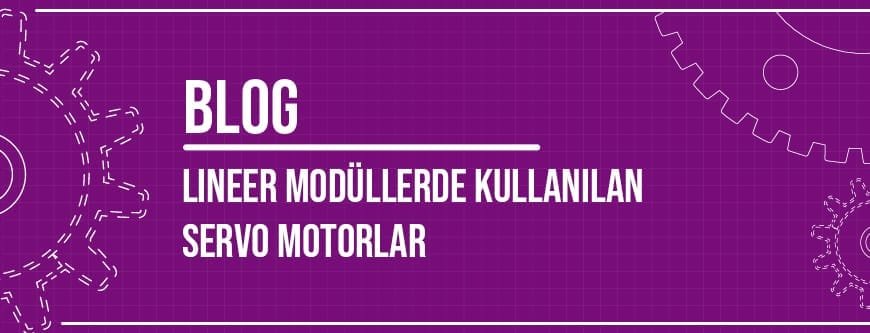
İçindekiler
Servo Motors Used in Linear Modules
Linear modules, which are frequently used in industrial areas, are used together with servo motors to ensure that linear motion is realized flawlessly. In this context, perfect results are obtained in applications where features such as precise positioning, high speed, torque and feedback are at the forefront. You can browse our content to have more information about the servo motors used in these highly flawless linear modules. In this way, you can have a more detailed idea about servo motors used in linear modules. We wish you a good day.
What is a Linear Module?
A linear module is a mechanical system used in industrial applications that require linear motion, providing high precision and fast positioning. These systems usually consist of a combination of components such as a slide, motor and drive system and reliably transmit linear motion. They are also used for material handling, positioning and precise positioning in applications such as automation lines, robotic systems, CNC machines and assembly lines. In this context, they offer solutions with various speeds, torques and load-carrying capacities, as they have different drive mechanisms such as ball screws, belt drives or linear motors.
Often with a compact design, linear modules also enable synchronized motion control in multi-axis systems when equipped with asas feedback systems and control protocols (e.g. EtherCAT). This increases productivity in industrial processes and ensures reliable performance even in complex production lines.
Linear Module Types
Motorized Linear Modules:
Motorized linear modules are modules that provide linear motion equipped with an electric motor (usually a servo or stepper motor). These modules are used in industrial applications that require high speed and precision. Thus, they provide linear motion in automation systems, assembly lines and robotic applications.
Pneumatic Linear Modules:
Pneumatic linear modules are modules that produce linear motion using compressed air. Thanks to their ability to provide fast and powerful motion, they are highly suitable for processes such as packaging, transportation and sorting. At the same time, they are frequently preferred in the field of industrial automation due to their low cost.
Hydraulic Linear Modules:
Hydraulic linear modules provide linear motion with fluid pressure and stand out with their heavy load carrying capabilities. In this context, hydraulic linear modules are a frequently preferred type of linear module in applications requiring high thrust, especially in automotive production and heavy industry applications.
Ball Screw Linear Modules:
Ball screw linearizers, which work with a ball screw system that converts rotary motion into linear motion, provide excellent performance in CNC machines, medical devices and other industrial areas that require precise positioning because they have high precision and repeatability.
Rack and Pinion Linear Modules:
They provide linear motion with a rack and pinion gear system. In this context, it is preferred in industrial applications that require linear transportation of heavy loads. For example, it is preferred in crane systems, transportation and automotive production lines.
Direct Drive Linear Motor Modules: Preferred for m lines.
Driven linear motor modules, which provide direct linear motion, do not require rotational motion. This makes them ideal for use in areas such as clean room applications, medical devices and semiconductor manufacturing, where high speed and precision are required. Therefore, it offers good performance in terms of use.
Telescopic Linear Modules:
Telescopic linear modules, which have an extensible structure, provide movement in narrow spaces and can be extended when necessary, creating a wide movement area. Especially; It is widely used in drawer systems, machine protective shields and storage solutions.
Magnetic Linear Modules:
Providing linear motion using a magnetic field, these modules offer contact-free motion, reducing the need for wear and maintenance. Due to these features, it is becoming a frequently preferred linear module type for clean rooms, medical devices and sensitive applications.
Multi-Axis Linear Modules:
They are modules that provide linear motion in more than one axis. These modules offer flexible movement capability in robotic systems and assembly / production lines that require complex movement, and provide versatile solutions by synchronizing movements in different axes.
Non-Driven Linear Modules:
These modules do not have their own motor or drive system and are moved by an external power source or mechanism. In simple handling and positioning applications, these linear modules provide cost savings and efficiency advantages.
What is the Working Principle of Linear Modules?
The operating principle of linear modules is based on the precise control of linear motion. At this point it is rotated by means of a drive mechanism (e.g. ball screw, belt or linear motor) or the linear motion is converted into linear motion on the slide system. This allows the slide or carrier platform to move linearly.
In ball screw systems, the motor rotates the shaft, allowing the carriage to move linearly, while in belt systems, the tension and movement of the belt ensures linear motion. Modules with linear motors generate linear motion directly by magnetic fields. In this case, the base also provides high speed and precision
Usage Area of Linear Modules
Since linear modules have different usage areas, they have different features and working principles. Therefore, if we need to take a look at these usage areas, they are as follows;
- Automation and Assembly Lines: Linear modules increase efficiency in production processes by providing speed, accuracy and repeatability in automation and assembly lines. At this point, linear modules are frequently used to precisely perform tasks such as part handling, assembly, gluing, welding and screwing on the production line. They also offer advantages in automotive, electronics and white goods assembly lines as they can handle heavy loads or large parts thanks to their fast response times and high torque capacity.
- Robotic Systems: Robotic systems, another area where linear modules are used, make it possible to move back and forth on a given linear axis, perform millimeter positioning and perform complex assembly or handling operations. It can also move heavy objects quickly and reliably. In addition, thanks to their fast response times, these modules increase the speed of production lines, increasing the efficiency of robotic processes and providing a reliable automation solution.
- CNC Machines and Machining: In CNC machines and machining systems, linear modules function as a critical component to ensure precise movement of workpieces in linear axes. These modules enable high accuracy and surface quality in complex machining processes. For example, in operations such as milling, drilling and turning, millimetric cuts can be made on workpieces thanks to the stable motion offered by linear modules. This ensures consistent production quality.
- Medical Devices and Laboratory Automation: In medical devices and laboratory automation, linear modules play an active role in processes that require high precision and repeatability. The linear movements of the devices used in these areas, such as sample preparation, pipetting, dosing and precise positioning, are performed flawlessly thanks to the precise linear motion provided by linear modules. Accuracy is critical, especially for instruments operating on a microscopic scale. For this reason, linear modules offer laboratory automation systems high precision and reliability when handling samples or positioning them for analysis.
- Packaging and Packaging: Linear modules play a critical role in packaging and packaging processes to ensure high speed, accuracy and efficiency. They make automation processes more effective by meeting the need for linear motion, especially in processes such as product handling, sorting, placement and packaging. Thanks to their fast response times, these modules allow products to be moved quickly and safely along the line and ensure that each pack is placed in a specific position with millimeter accuracy. This contributes to smooth and uninterrupted operations.
- Food and Pharmaceutical Production: Linear modules offer an ideal solution for processes in food and pharmaceutical manufacturing that require high hygiene standards and precise control. In these industries, linear motion systems are critical for processing, handling and packaging products in a safe and hygienic environment. Especially in food production, linear modules provide high speed and accuracy in steps such as cutting, portioning, filling and packaging of ingredients in the right amount. In pharmaceutical production, they enable processes such as capsule filling, bottling, labeling and dosing to be carried out with millimeter precision, ensuring that each product complies with safety and quality standards.
- Warehousing and Logistics: In the warehousing and logistics industry, linear modules are indispensable for fast, reliable and accurate material handling and placement. Linear modules offer an effective solution in applications that require linear movement in processes such as placing, moving, sorting and packaging products on shelves. In particular, it accelerates the transportation and positioning of goods to certain points and reduces errors caused by manpower.
Why Servo Motors Should Be Preferred in Linear Modules?
In linear modules, servo motors provide significant advantages in applications requiring linear motion thanks to their high precision, speed and control capabilities and are therefore preferred. At this point, since servo motors are equipped with feedback systems, they precisely control the position, speed and torque of the motor, which provides excellent performance in applications requiring high accuracy. In addition, when servo motors are used in linear modules, they allow systems to operate more efficiently thanks to their fast response times. This increases process speed in automation, assembly, robotics, packaging and CNC applications.
In addition, servo motors attract attention with their silent and vibration-free operation. This feature allows them to be preferred especially in sensitive working environments such as medical, food and pharmaceuticals. Considering all these advantages, servo motors are preferred for their accuracy, efficiency, safety and cost savings in linear modules and offer an ideal solution in industrial automation applications.
How to Mount Linear Modules to Servo Motors?
When mounting linear modules to servo motors, there are certain steps that must be taken to ensure correct operation and precision. These steps help linear modules to perform well. Here is the process of assembling linear modules to servo motors;
Checking Motor and Module Compatibility:
- Before starting the installation, it must be checked whether the technical specifications of the servo motor and the linear module are compatible with each other. Therefore, make sure that the motor and module are compatible in terms of power, torque, speed and connection compatibility.
Preparing the Mounting Plate:
- A mounting plate is usually placed between the servo motor and the linear module. This plate provides a solid connection between the motor and the module and reduces vibration. For this reason, the mounting plate should be selected according to the dimensions of the motor and should be suitable for the connection points of the module.
Fixing the Motor to the Module:
- The servo motor is carefully inserted into the motor mount of the module and secured with screws at the connection points. During the screwing process, make sure that the connection screws are tight but do not force the motor. Loose or excessively tight screws at this stage may cause loss of sensitivity.
Coupling Assembly:
- A coupling is placed between the motor shaft and the drive shaft of the linear module. The coupling is a connecting element that converts the rotary motion of the motor into linear motion. It must be ensured that the coupling is fully seated on the motor shaft and the module shaft. In addition, flexible couplings are preferred, helping the system to operate vibration-free and precisely.
Engine Alignment:
- Make sure that the axes of the motor and the module are exactly aligned. Otherwise, misalignment may cause vibrations or loss of performance of the module. Therefore, the axes must be checked using an alignment ruler or laser alignment tools.
Making Electrical Connections:
- Make sure that the cables of the motor are correctly connected to the drive or control unit and that the grounding and feedback systems are properly connected. Protective sheaths can also be used to prevent damage to the cables.
Control and Testing:
- Once the assembly is complete, testing should be carried out to check that the servo motor and linear module are working correctly. To do this, several motion tests at low speed should be carried out to make sure that the alignment, connections and movement are correct and if there is any noise, vibration or unexpected movement, the connections should be checked again.
Calibration and Adjustment:
- After the assembly is completed, the servo motor and linear module should be calibrated in the control unit, and the speed, torque and position parameters of the motor should be adjusted with the calibration and the system should operate with the desired accuracy.
What Advantages Do Servo Systems Offer to Linear Modules?
Servo systems offer a number of advantages to linear modules, providing efficiency, precision and performance in industrial applications that require linear motion. At this point, the main advantages of servo systems to linear modules are as follows;
- Servo systems realize position, speed and torque control with millimeter accuracy thanks to feedback mechanisms. This enables linear modules to operate with high accuracy, especially in applications where precise positioning and linear motion are required.
- Thanks to their fast response time, servo motors respond instantly to sudden speed changes and motion commands. This allows linear modules to work efficiently in high-speed production lines and automation systems.
- Servo systems consume only as much power as is required, thus ensuring energy efficiency. This feature, which reduces the running costs of linear modules, offers significant energy savings to businesses in the long term.
- The high torque capacity of servo systems helps to move even heavy loads smoothly and precisely, which is an advantage in applications requiring heavy load handling and high speed.
- Servo systems offer low vibration and quiet operation. Thus, the quiet operation of linear modules helps them to be preferred in areas such as sensitive applications, medical devices and laboratory automation that require a noiseless environment.
- Servo motors provide high repeatability because they can repeat movements with the same accuracy every time. This improves quality and efficiency in automation lines where the same process needs to be performed with repeated accuracy.
- Braked servo systems provide safety by stabilizing the position of the motor in case of power failure or emergency. Braked servo motors used in linear modules provide additional safety, especially in applications where precise stopping is required.
Linear Module Installation and Integration in Servo Systems
Linear module installation and integration in servo systems requires a careful process for efficient operation of linear motion systems. First, the power, torque and speed compatibility of the servo motor and linear module must be checked. Then, a suitable coupling is placed between the motor shaft and the linear module, ensuring a robust and correctly aligned assembly between the motor and the module. This coupling precisely translates rotary motion into linear motion. During installation, it is critical that the axis of the servo motor is fully aligned with the linear motion axis of the linear module to prevent vibrations and wear. During installation, it is critical that the axis of the servo motor is fully aligned with the linear motion axis of the linear module to prevent vibrations and wear.
In the integration phase, speed, position and torque parameters are set via the servo driver, enabling the linear module to reach the targeted position with high accuracy. Thus, it is possible to synchronize the servo motor to multi-axis systems using industrial communication protocols such as EtherCAT or Modbus.
This installation and integration process maximizes the efficiency of the system by ensuring that the linear modules respond quickly, operate with high precision and integrate perfectly into the production line.
How to Maintain Servo Systems in Linear Modules?
Maintenance of servo systems used in linear modules is an important process that must be performed regularly for efficient and long-lasting operation of the system. First, the slides and moving parts of the module should be cleaned of dust and dirt and lubricated with oil or grease recommended by the manufacturer. This process reduces friction and prevents wear. In addition, the connection and alignment of the coupling between the servo motor and the linear module should be checked regularly. Loose or worn connections can then be corrected.
Since the feedback system is a critical component that ensures the precision of the motor, it is important to ensure that elements such as encoders or resolvers are functioning correctly. Also, the alignment of the motor and module axes should be checked periodically. Otherwise, misalignment can cause problems such as excessive vibration and rapid wear.
If you are looking for a servo motor to use in linear modules, you can contact Şahin Rulman’s expert team and choose the most suitable servo motor.
FAQ
Why is a servo motor preferred for linear modules?
This is because servo motors can provide precise control, fast movement and high repeatability. In particular, these privileges meet the accuracy and speed requirements in robotic applications, assembly lines and packaging systems.
Which type of servo motors are used in linear modules?
AC servo motors and sometimes DC servo motors are generally used in linear modules. Depending on the application requirements, servomotors with different power capacities such as braked or unbraked can be selected.
In which industrial areas are servo motors used for linear modules?
Servo motors are used for linear modules in many industrial areas. For example; Servo motors are widely used in applications that require linear motion in areas such as robotic systems, CNC machines, automation lines, assembly systems, medical devices, packaging and storage systems.
Do linear modules with servo motors save energy?
Yes, linear modules with servo motors provide energy efficiency. In this context, since servo motors can operate with high precision, they minimize unnecessary movements and increase the efficiency of the system at a high level.
Which protocols are used to control servo motors in linear modules?
Communication protocols such as EtherCAT, Modbus and CANopen are widely used. These protocols transmit data to servomotors to enable synchronized motion control in multi-axis systems.
At what speeds can linear modules with servo motors operate?
The speed range varies depending on the power of the motor, the load capacity and the requirements of the application. However, servo motors have the ability to provide high speed and fast response time. This makes them ideal for high-speed automation applications.
Diğer Blog Yazılarımız



